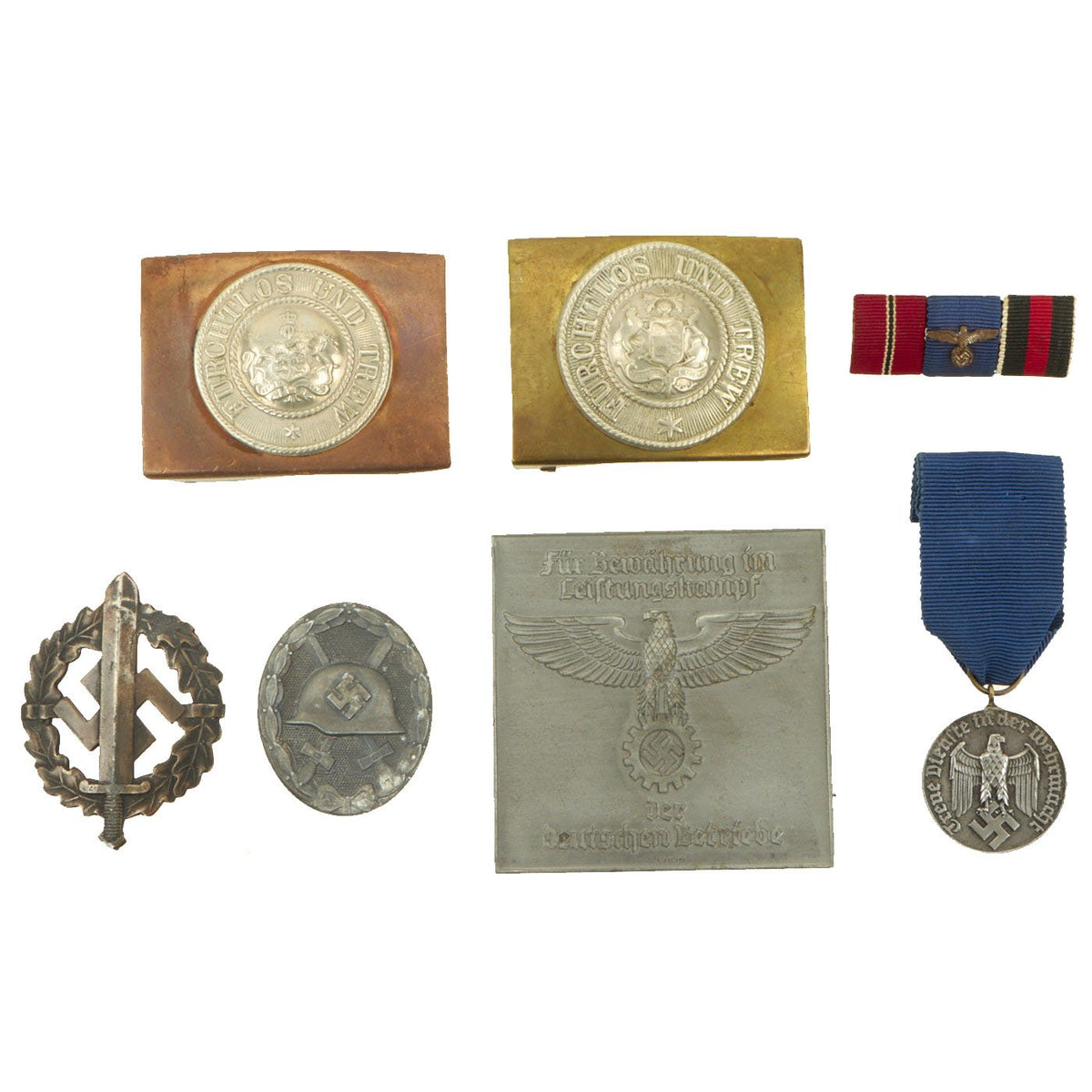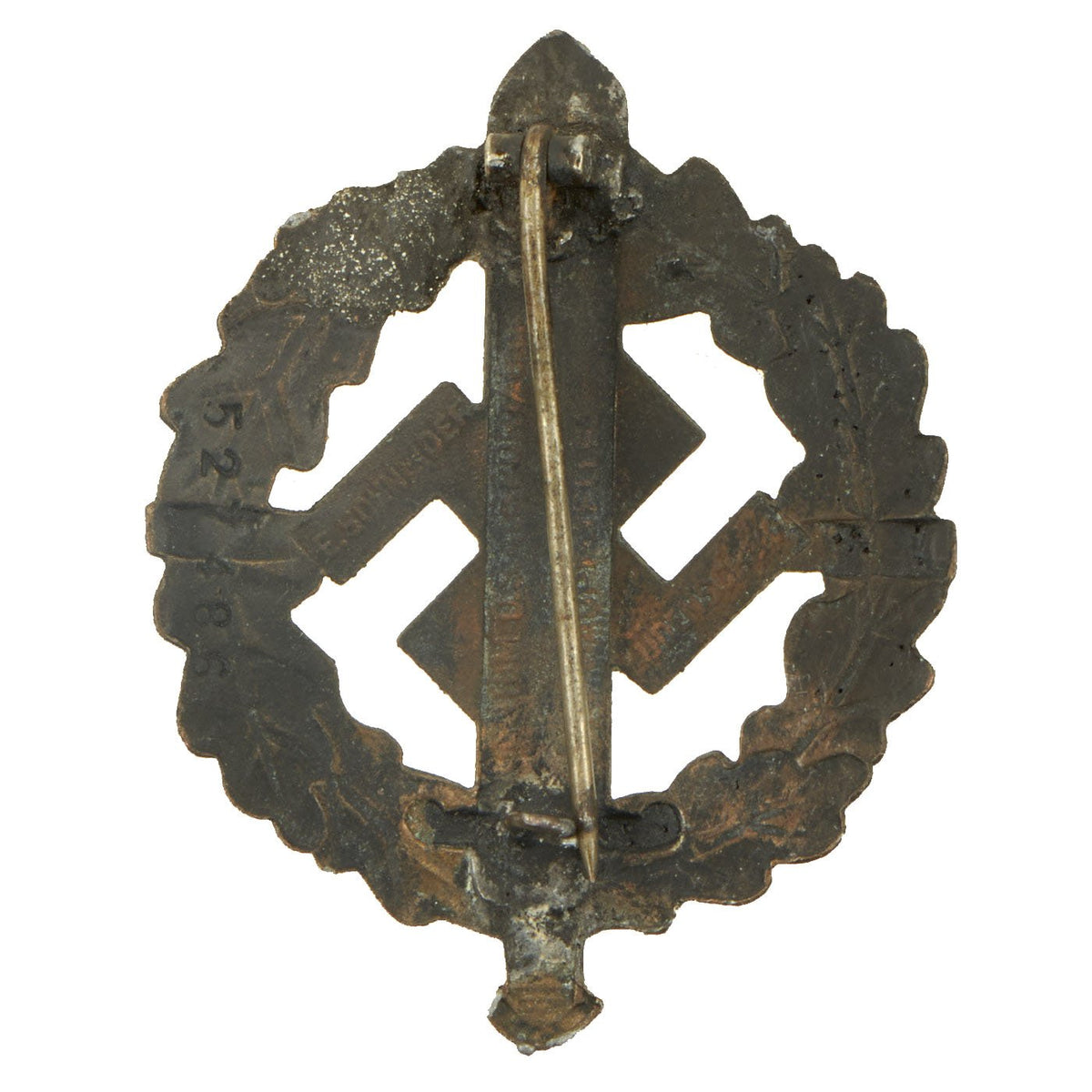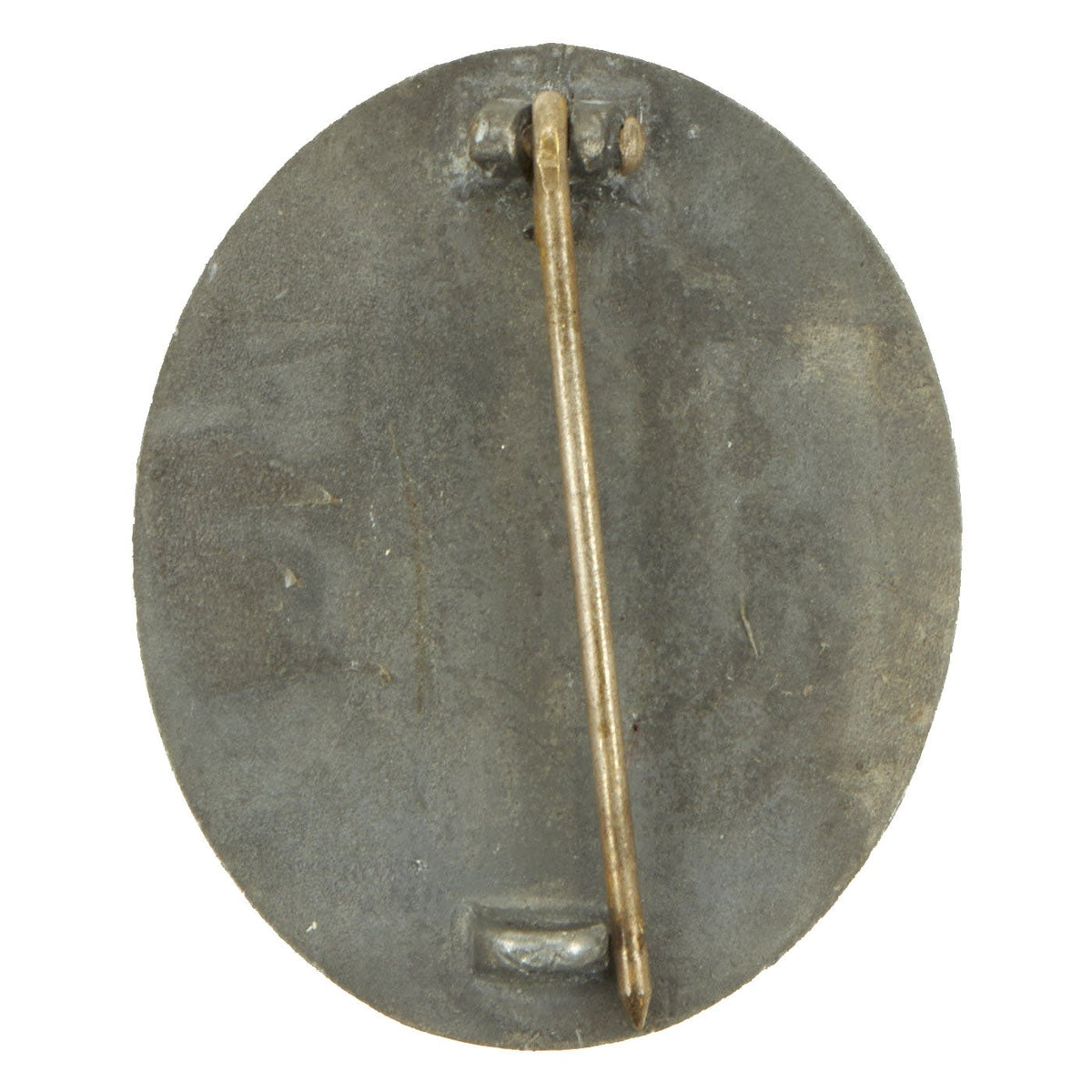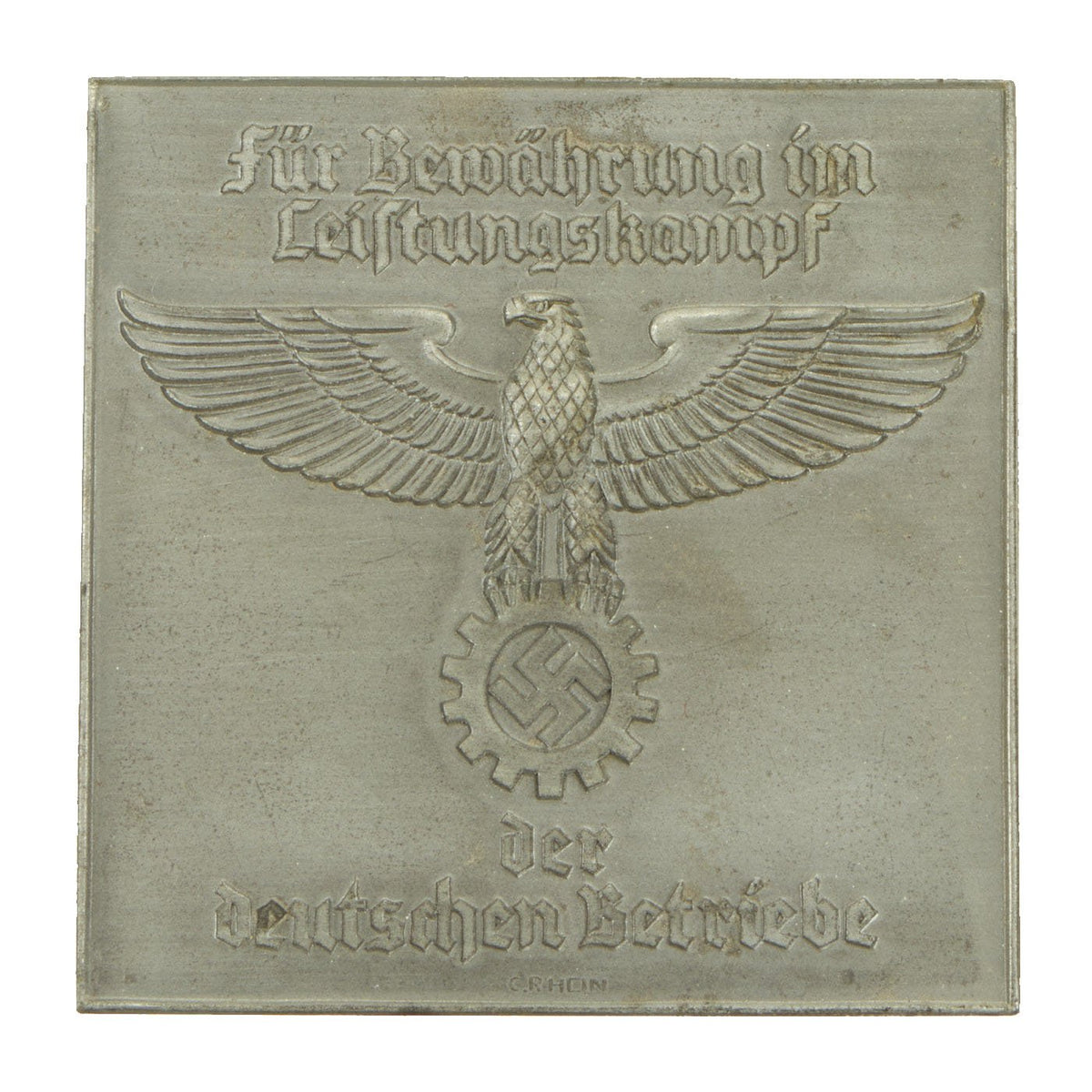Original German WWI & WWII Medal & Belt Buckle Grouping with Wound Badge & Long Service Award – 7 Items Original Items
$ 295,00 $ 118,00
Original Item: One-of-a-kind Set. This is a very nice collection of Imperial German WWI Belt buckles with German WWII Insignia & Awards, which was brought back from the European theater by a USGI after the war was concluded. It includes two very interesting belt buckles, a Wehrmacht Long Service award, and more!
This lovely set includes:
– One Imperial German WWII M1895 Brass and Nickel Belt Buckle (Koppelschloß) from the Kingdom of Württemberg, showing the coat of arms with FURCHTLOS UND TREW (Fearless and True” surrounding it.
– One Imperial German WWII M1895 Copper and Nickel Belt Buckle (Koppelschloß) from the Kingdom of Württemberg, showing the coat of arms with FURCHTLOS UND TREW (Fearless and True” surrounding it.
– One German WWII SA-Wehrmannschaft Sports Badge in Bronz Grade by E. Schneider. Known in German as the sportabzeichen, these were awarded to members of the SA for athletic achievement during the annual sports festivals. These were all part of a larger SA-Wehrmannschaft program, intended to train members of the SA.
– One German WWII Solid Back Silver 2nd Class Wound Badge with a functional pinback. Unmarked.
– One German WWII Wehrmacht Heer 3rd Class Long Service Award – 12 Years with Ribbon
– One Ribbon Bar, which looks to be for an Eastern Front Medal, 4 Year Wehrmacht long Service Medal, and what looks to be a Sudetenland or War Cross of Honor.
– One German WWII DAF German Labor Front Presentation Plaque from Gau Schleswig-Holstein. Measures 2 3/4″ square.
A lovely set of German WWI & WWII militaria, a great start to any collection!
The German Wound Badge (Verwundetenabzeichen) was instituted by Kaiser Wilhelm II on 3 March 1918 during the First World War to recognize those wounded in the conflict. It was designed using a World War One style Imperial German Stahlhelm helmet as the main motif. The helmet was set on top two crossed swords against a pebbled background and surrounded by a laurel leaves wreath.
The Wound Badge Awards came in three different types of grades representing the amount , or severity, of wounds received. The first grade, the Black Wound Badge was awarded for 1 to 2 wounds received in combat. The Silver Grade was awarded for 3 to 4 wounds, and finally the Gold Grade for 5 or more wounds, total disability, or death.
Wehrmacht Long Service Awards – 18, 12, and 4 Years:
This award was a military service decoration of NSDAP Germany issued for satisfactory completion of a number of years in military service. The award itself is cumulative, so after the 3rd class, both a cross and a medal were worn, and the color indicated service.
On 16 March, 1936, Adolf AH ordered the institution of service awards for the first four classes, each reflecting the completion of a select number of years of military service.
Each branch of the Wehrmacht (army, navy, and air force) maintained their own version of the Long Service Award and the decoration was issued for four years (silver medal – fourth class), 12 years (gold medal – third class), 18 years (silver cross – second class), 25 years (gold cross – first class), and 40 years (1939 special class). The 40 years special class service award was introduced on 10 March 1939.
Professor Dr Richard Klein designed the awards. Recipients of lower year awards would wear the decoration simultaneously with higher level decorations. The manner they could be worn was:
3rd Class with 4th Class (gold medal with silver medal)
2nd Class with 4th Class (silver cross with silver medal)
1st Class with 3rd Class (gold cross with gold medal)
The Long Service Award was retroactive throughout a service member’s career, encompassing Reichswehr service as well as service dating during and before World War I. As such, there were a handful of 40 year awards presented, even though the NSDAP era only lasted 12 years (1933-1945).
Fast Shipping with Professional Packaging
Thanks to our longstanding association with UPS FedEx DHL, and other major international carriers, we are able to provide a range of shipping options. Our warehouse staff is expertly trained and will wrap your products according to our exact and precise specifications. Prior to shipping, your goods will be thoroughly examined and securely secured. We ship to thousands clients each day across multiple countries. This shows how we're dedicated to be the largest retailer on the internet. Warehouses and distribution centres can be located throughout Europe as well as the USA.
Note: Orders with more than one item will be assigned a processing date depending on the item.
Before shipping before shipping, we'll conduct a thorough inspection of the items you have ordered. Today, the majority of orders will be delivered within 48 hours. The delivery time will be between 3-7 days.
Returns
The stock is dynamic and we cannot completely manage it because multiple stakeholders are involved, including our factory and warehouse. So the actual stock may alter at any time. It's possible that you may not receive your order once the order has been made.
Our policy is valid for a period of 30 days. If you don't receive the product within 30 days, we are not able to issue a refund or an exchange.
You can only return an item if it is unused and in the same state as the day you received it. You must have the item in its original packaging.
Related products
Uncategorized
Uncategorized
Uncategorized
Uncategorized
Uncategorized
Uncategorized
Uncategorized
Uncategorized
Uncategorized
Armoured Fighting Vehicles of the World: AFVs of World War One (Hardcover Book) New Made Items
Uncategorized
Uncategorized
Armored Burgonet Helmet & Polearm from Scottish Castle Leith Hall Circa 1700 Original Items
Uncategorized
Band of Brothers ORIGINAL GERMAN WWII Le. F.H. 18 10.5cm ARTILLERY PIECE Original Items
Uncategorized
Uncategorized
Uncategorized
Uncategorized
Uncategorized












































































